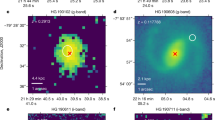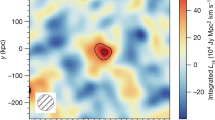Abstract
The large-scale structure in the distribution of galaxies is thought to arise from the gravitational instability of small fluctuations in the initial density field of the Universe. A key test of this hypothesis is that forming superclusters of galaxies should generate a systematic infall of other galaxies. This would be evident in the pattern of recessional velocities, causing an anisotropy in the inferred spatial clustering of galaxies. Here we report a precise measurement of this clustering, using the redshifts of more than 141,000 galaxies from the two-degree-field (2dF) galaxy redshift survey. We determine the parameter β = Ω0.6/b = 0.43 ± 0.07, where Ω is the total mass-density parameter of the Universe and b is a measure of the ‘bias’ of the luminous galaxies in the survey. (Bias is the difference between the clustering of visible galaxies and of the total mass, most of which is dark.) Combined with the anisotropy of the cosmic microwave background, our results favour a low-density Universe with Ω ≈ 0.3.
This is a preview of subscription content, access via your institution
Access options
Subscribe to this journal
Receive 51 print issues and online access
$199.00 per year
only $3.90 per issue
Buy this article
- Purchase on Springer Link
- Instant access to full article PDF
Prices may be subject to local taxes which are calculated during checkout





Similar content being viewed by others
References
Hubble, E. P. The distribution of extra-galactic nebulae. Astrophys. J. 79, 8–76 (1934).
Kirshner, R. P., Oemler, A., Schechter, P. L. & Shectman, S. A. A million cubic megaparsec void in Bootes. Astrophys. J. 248, L57–L60 (1981).
Davis, M. & Peebles, P. J. E. A survey of galaxy redshifts. V–The two-point position and velocity correlations. Astrophys. J. 267, 465–482 (1983).
Bean, A. J., Ellis, R. S., Shanks, T., Efstathiou, G. & Peterson, B. A. A complete galaxy redshift sample. I–The peculiar velocities between galaxy pairs and the mean mass density of the Universe. Mon. Not. R. Astron. Soc. 205, 605–624 (1983).
de Lapparent, V., Geller, M. J. & Huchra, J. P. A slice of the universe. Astrophys. J. 302, L1–L5 (1986).
Kaiser, N. A sparse-sampling strategy for the estimation of large-scale clustering from redshift surveys. Mon. Not. R Astron. Soc. 219, 785–790 (1986).
Saunders, W. et al. The density field of the local universe. Nature 349, 32–38 (1991).
Shectman, S. A. et al. The Las Campanas redshift survey. Astrophys. J. 470, 172–188 (1996).
Taylor, K., Cannon, R. D. & Watson, F. G. Anglo-Australian Telescope's 2dF facility. Proc. SPIE 2871, 145–149 (1999).
Colless, M. First results from the 2dF galaxy redshift survey. Phil. Trans. R. Soc. Lond. A 357, 105–116 (1999).
Maddox, S., Efstathiou, G. & Sutherland, W. J. The APM Galaxy Survey–III. An analysis of systematic errors in the angular correlation function and cosmological implications. Mon. Not. R. Astron. Soc. 283, 1227–1263 (1996).
Kaiser, N. Clustering in real space and in redshift space. Mon. Not. R. Astron. Soc. 227, 1–21 (1987).
Hamilton, A. J. S., Tegmark, M. & Padmanabhan, N. Mon. Not. R. Astron. Soc. 317, L23–L27 (2000).
Pen, U.-L. Reconstructing nonlinear stochastic bias from velocity space distortions. Astrophys. J. 504, 601–606 (1998).
Dekel, A. & Lahav, O. Stochastic nonlinear galaxy biasing. Astrophys. J. 520, 24–34 (1999).
Benson, A. J., Cole, S., Frenk, C. S., Baugh, C. M. & Lacey, C. G. The nature of galaxy bias and clustering. Mon. Not. R. Astron. Soc. 311, 793–808 (2000).
Kauffmann, G., Nusser, A. & Steinmetz, M. Galaxy formation and large-scale bias. Mon. Not. R. Astron. Soc. 286, 795–811 (1997).
Strauss, M. A. & Willick, J. A. The density and peculiar velocity fields of nearby galaxies. Phys. Rep. 261, 271–431 (1995).
Hamilton, A. J. S. in The Evolving Universe Vol. 185, 231 (Kluwer Astrophysics and Space Science Library, Kluwer, Dordrecht, 1998); also preprint astro-ph/9708102 at 〈xxx.lanl.gov〉 (1997).
Taylor, A. N., Ballinger, W. E., Heavens, A. F. & Tadros, H. Application of data compression methods to the redshift-space distortions of the PSCz galaxy catalogue. Mon. Not. R. Astron. Soc. (in the press); also preprint astro-ph/0007048 at 〈xxx.lanl.gov〉 (2000).
Outram, P. J., Hoyle, F. & Shanks, T. The Durham/UKST galaxy redshift survey–VII. Redshift-space distortions in the power spectrum. Mon. Not. R. Astron. Soc. (in the press); also preprint astro-ph/0009387 at 〈xxx.lanl.gov〉 (2000).
Hamilton, A. J. S. Toward better ways to measure the galaxy correlation function. Astrophys. J. 417, 19–35 (1993).
Landy, S. D. & Szalay, A. S. Bias and variance of angular correlation functions. Astrophys. J. 412, 64–71 (1993).
Cole, S., Hatton, S., Weinberg, D. H. & Frenk, C. S. Mock 2dF and SDSS galaxy redshift surveys. Mon. Not. R. Astron. Soc. 300, 945–966 (1998).
Feldman, H. A., Kaiser, N. & Peacock, J. A. Power-spectrum analysis of three-dimensional redshift surveys. Astrophys. J. 426, 23–37 (1994).
Meiksin, A. A. & White, M. The growth of correlations in the matter power spectrum. Mon. Not. R. Astron. Soc. 308, 1179–1184 (1999).
Scoccimarro, R., Zaldarriaga, M. & Hui, L. Power spectrum correlations induced by nonlinear clustering. Astrophys. J. 527, 1–15 (1999).
Szalay, A. S., Matsubara, T. & Landy, S. D. Redshift-space distortions of the correlation function in wide-angle galaxy surveys. Astrophys. J. 498, L1–L4 (1998).
Folkes, S. J. et al. The 2dF galaxy redshift survey: spectral types and luminosity functions. Mon. Not. R. Astron. Soc. 308, 459–472 (1999).
Benoist, C., Maurogordato, S., da Costa, L. N., Cappi, A. & Schaeffer, R. Biasing in the galaxy distribution. Astrophys. J. 472, 452–459 (1996).
Loveday, J., Maddox, S. J., Efstathiou, G. & Peterson, B. A. The Stromlo-APM redshift survey. 2: Variation of galaxy clustering with morphology and luminosity. Astrophys. J. 442, 457–468 (1995).
Carlberg, R. G. et al. Galaxy clustering evolution in the CNOC2 high-luminosity sample. Astrophys. J. 542, 57–67 (2000).
Verde, L., Heavens, A. F., Matarrese, S. & Moscardini, L. Large-scale bias in the Universe–II. Redshift-space bispectrum. Mon. Not. R. Astron. Soc. 300, 747–756 (1998).
Jaffe, A. et al. Cosmology from Maxima-1, Boomerang and COBE/DMR CMB Observations; preprint astro-ph/0007333 at 〈xxx.lanl.gov〉 (2000).
Mould, J. R. et al. The Hubble Space Telescope key project on the extragalactic distance scale. XXVIII. Combining the constraints on the Hubble constant. Astrophys. J. 529, 786–794 (2000).
Freedman, W. L. et al. Final results from the Hubble Space Telescope key project to measure the Hubble constant; preprint astro-ph/0012376 at 〈xxx.lanl.gov〉 (2000).
Ballinger, W. E., Peacock, J. A. & Heavens, A. F. Measuring the cosmological constant with redshift surveys. Mon. Not. R. Astron. Soc. 282, 877–888 (1996).
Hatton, S. & Cole, S. Modelling the redshift-space distortion of galaxy clustering. Mon. Not. R. Astron. Soc. 296, 10–20 (1998).
Baugh, C. M. & Efstathiou, G. The three-dimensional power spectrum measured from the APM galaxy survey–2. Use of the two-dimensional power spectrum. Mon. Not. R. Astron. Soc. 267, 323–332 (1994).
Hamilton, A. J. S. Measuring omega and the real correlation function from the redshift correlation function. Astrophys. J. 385, L5–L8 (1992).
Jing, Y. P., Mo, H. J. & Börner, G. Spatial correlation function and pairwise velocity dispersion of galaxies: Cold dark matter models versus the Las Campanas survey. Astrophys. J. 494, 1–12 (1998).
Jenkins, A. R. et al. Evolution of structure in cold dark matter universes. Astrophys. J. 499, 20–40 (1998).
Peacock, J. A. & Dodds, S. J. Non-linear evolution of cosmological power spectra. Mon. Not. R. Astron. Soc. 280, L19–L26 (1996).
Acknowledgements
The 2dF Galaxy Redshift Survey was made possible through the dedicated efforts of the staff of the Anglo-Australian Observatory, both in creating the two-degree-field instrument and in supporting it on the telescope.
Author information
Authors and Affiliations
Corresponding author
Rights and permissions
About this article
Cite this article
Peacock, J., Cole, S., Norberg, P. et al. A measurement of the cosmological mass density from clustering in the 2dF Galaxy Redshift Survey. Nature 410, 169–173 (2001). https://doi.org/10.1038/35065528
Received:
Accepted:
Issue Date:
DOI: https://doi.org/10.1038/35065528
This article is cited by
-
(DarkAI) Mapping the large-scale density field of dark matter using artificial intelligence
Science China Physics, Mechanics & Astronomy (2024)
-
Quasi static analysis of axially symmetric radiating system in f(R) gravity
Indian Journal of Physics (2024)
-
Experiments with levitated force sensor challenge theories of dark energy
Nature Physics (2022)
-
Astrophotonics: astronomy and modern optics
The Astronomy and Astrophysics Review (2021)
-
No evidence for modifications of gravity from galaxy motions on cosmological scales
Nature Astronomy (2018)
Comments
By submitting a comment you agree to abide by our Terms and Community Guidelines. If you find something abusive or that does not comply with our terms or guidelines please flag it as inappropriate.



